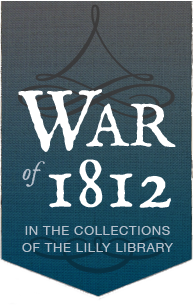First steps
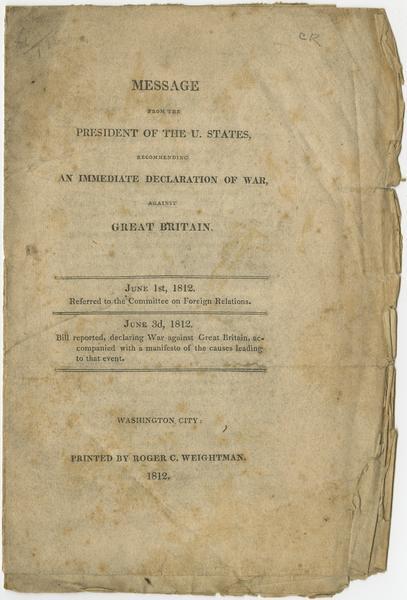
Message from the President of the U. States : recommending an immediate declaration of war against Great Britain. (1812.)
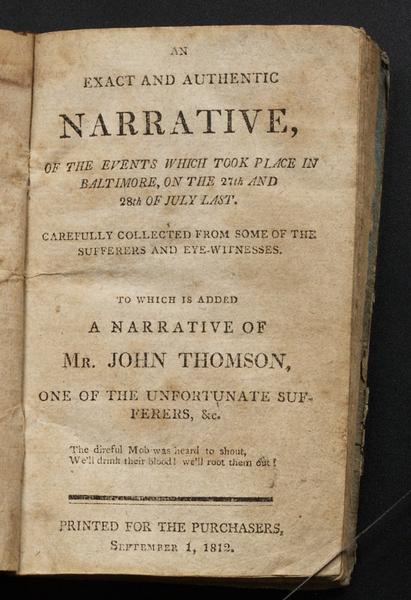
An exact and authentic narrative of the events which took place in Baltimore, on the 27th and 28th of July last. Carefully collected from some of the sufferers and eyewitnesses. To which is added a narrative of Mr. John Thomson, one of the unfortunate sufferers, &C. --- (1812.)
Declaration of War — Baltimore Riots
The United States declared war on June 18, 1812, with the Twelfth Congress passing the measure on a nearly party-line vote. Word of the declaration reached Britain at the end of July, as the British ambassador returned home with the news and with new peace terms offered by President Madison. Though Britain had already repealed the Orders-in-Council that restricted trade with the Continent, the two nations could not find common ground on the issue of impressment. On October 13, 1812, the British government issued another Order-in-Council enabling British forces to enter into the conflict.
Opposition to the war did not end upon its official declaration. Though war hawks unsuccessfully promoted a sedition act to quash criticism of the war, Federalists in New England and elsewhere continued to speak out, discussing possible action in legislatures and other groups. Where those opposed to the war were in the minority, mobs sometimes sought to silence criticism through violence. Notorious riots in Baltimore targeted a Federalist newspaper publisher, persisting for six weeks and resulting in burned buildings and a number of deaths.
Military action in the War of 1812 occurred in several theaters. The borderlands between Canada and the United States were the most important area of conflict. It was not that the acquisition of Canada was a top military goal, but British North America was the closest place to strike at Britain. Fighting centered on and around Lake Ontario and Lake Erie, both in Upper and Lower Canada, and in the Old Northwest, consisting of Ohio and the Michigan and Indiana Territories. Later in the war, significant fighting took place in the Chesapeake Bay area and in the south.
Related Items

A declaration of war
Message from the President of the U. States: recommending an immediate declaration of war against Great Britain. Washington: R.C. Weightman, 1812.
The declaration of war was approved and signed into law on June 18, 1812, approximately two weeks after the bill was reported out of the Committee on Foreign Relations.

Maine against the war
Resolutions from a meeting of delegates from different towns in the county of Lincoln held at Wiscasset, Maine. August 3, 1812.
The resolutions of this meeting in Lincoln County, Maine, reflected the concerns of merchants and residents of the “defenceless…sea coasts.” They found fault in the country’s leadership that entered into this “unnecessary, impolitic, and ruinous” war and advocated giving the people of state a voice in the selection of electors.
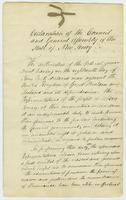
Opposition from New Jersey
New Jersey Legislature. Declaration of the Council and General Assembly of the State of New Jersey. Resolutions remonstrating against the war with Great Britain. November 11, 1812.
Anti-war sentiment remained strong throughout the war. In this document, the Council and General Assembly of New Jersey outlined their opposition and openly criticized sailors’ rights as a basis for war: “We do hereby declare our solemn conviction that a war at the expense of American Blood and Treasure to protect British subjects on the high seas from their due alligiance to their country, would be unjust.”

Eyewitness accounts of the Baltimore riots
An exact and authentic narrative of the events which took place in Baltimore, on the 27th and 28th of July last. Carefully collected from some of the sufferers and eyewitnesses. Georgetown: Printed for the purchasers, 1812.
This collection of eyewitness accounts of the Baltimore riots describes the burning of the offices of the anti-war Federal Republican newspaper office. The publisher and several friends later returned to Baltimore where they barricaded themselves against further attacks first in a house, and later in a jail, supposedly under the protection of Baltimore authorities. The jail afforded little protection in the end, and on page 32, the death of General James McCubbin Lignan is described: Lignan “so much mistook the character of the monsters, as to suppose them capable of feelings of humanity. He reminded them that he had fought for their liberties throughout the revolutionary war, that he was old, infirm, and that he had a large and helpless family dependent upon him for support. These remarks served only to attract their attention to him…” On page 43 (image 47) John Thomson describes a night of torture and torment in which he was tarred and feathered and suffered “upwards of eighteen cuts of the sword.”
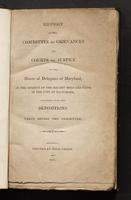
Government report on the riots in Baltimore
Maryland. General Assembly. Report of the Committee of Grievances and Courts of Justice of the House of Delegates of Maryland on the subject of the recent mobs and riots in the city of Baltimore. Annapolis: Printed by Jonas Green, 1813.
The report described the brutal attack on the jail as “a scene of horror and murder…which for its barbarity has no parallel in the history of the American people, and no equal but in the massacres of Paris.”Appended to the report are more than 300 pages of depositions related to the violence.
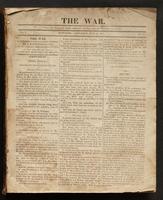
The War: A newspaper
The War. New York: S. Woodworth & Co., 1812-1817.
Samuel Woodworth is better known today as a poet and playwright, but he published a number of newspapers and journals. The War began publication in June of 1812, and Woodworth intended the paper to serve both as a news source and as a history. In a notice published in the first issue of volume three (image 459), the editor saw the end of the war in sight and announced plans to include a chronological index to the publication (found at image 500) as well as his intent to publish various state documents which "want of room has heretofore excluded."


